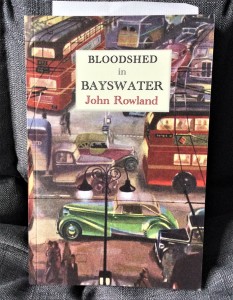It’s been a little while since I featured any Golden Age crime on the Ramblings, and after the heavier reads at the end of May (Bulgakov, Perec) I felt in need of a little contrast. Fortunately, lovely Galileo Publishers came to the rescue, as they’ve been kind enough to send me a wonderful selection of review copies. It was hard to choose as all of them sound marvellous, but in the end I went for a title by an author I’ve read before – “Bloodshed in Bayswater” by John Rowland.
I’ve read a couple of Rowland’s mysteries before, as two titles (“Calamity in Kent” and “Murder in the Museum“) have been reissued as British Library Crime Classics. I enjoyed both of them immensely, so was very much looking forward to this story, first published in 1935. Once again, the detecting is done by Rowland’s regular sleuth, Inspector Shelley – though much of the story is related from the viewpoint of our main protagonist, Margery Latimer. A secretary who lives in a boarding house in Bayswater, she’s awakened one night by a scream outside her window. Peering out, she sees a man hurrying away from a car and down the street; and the arrival of the police reveals that she has been witness to a murder. The authorities are baffled, but Margery is flummoxed the next day when she arrives at work. Her employer, Mr Bellingham, a man who’s been her guardian for most of her life, seems agitated; and he explains he’s about to retire, and encourages her to take up new employment.
The outfit he’s steering her towards is the National Anti-Speed Association, and the man running this is one John Cook. Imagine Margery’s surprise on meeting him, then, to find that he’s the man she saw running away from the crime scene the previous night. For some reason, however, she’s reluctant to reveal this to Shelley… Margery takes the job, but then another murder follows and Shelley begins to dig deeper. Margery herself tries to do a little investigation, but events become murkier and murkier, and she reveals more questions than answers! Why *is* John Cook really running the Association? Why is Mr. Bellingham behaving so oddly and very much out of character? When Cook disappears and the murders continue, events will become very dangerous for Margery, and the plot will be much darker than originally appeared…
“Bloodshed…” is an engrossing and very enjoyable read, and if I’m honest is not so much a pure crime classic as a criminal caper with thriller elements (which is how I felt about “Calamity..”) Rowland seems to enjoy pairing his detective with a member of the public who’s swept up in the action and tries to do a bit of detecting, and that works well here. Margery is a plucky and winning heroine, obviously somewhat smitten with Cook and determined to prove his innocence, and so this of course puts her at odds with Shelley at times. There are plenty of red herrings, a likeable office boy, some ruthless criminals and an unexpected motive behind all of this!
As for the solution, well I did and I didn’t see it coming! Rowland plays fair in many respects, and I suspected one particular character from hints he placed during the narrative – although my suspicion of their guilt didn’t reveal the whole story behind their motivations. The reasons for the murders were something I didn’t pick up on, as these are much more complex than seems at the start of the book; and what seem to be killings from some kind of fanatical reason actually have a bigger plot behind them. There’s plenty of excitement as the mystery builds to a climax. and the big reveal is very satisfying (although you *do* have to be prepared to accept some elements which might not be so convincing nowadays).
So “Bloodshed in Bayswater” really hit the spot. It’s an engaging and entertaining mystery thriller, with a bit of romance thrown in for good measure, and plenty of pace, which did keep me hooked until the end. The criminals really are baddies, there are clandestine organisations, petty crooks, plodding and not-so-plodding policemen and, all in all, I enjoyed re-encountering the writing of John Rowland. I don’t know what else of his is currently in print, apart from the three titles I’ve mentioned, but I shall certainly look out for more of them!
(Review copy kindly provided by the publishers, for which many thanks!)









